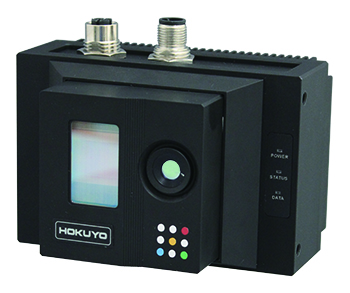From: https://hokuyo-usa.com/resources/blog/pioneering-autonomous-capabilities-solid-state-3d-lidar
Autonomous technologies are proliferating across industries at breakneck speed. Various sectors, like manufacturing, agriculture, storage, freight, etc., are rushing to embrace robotics, automation, and self-driving capabilities.
At the helm of this autonomous transformation is LiDAR, the eyes that allow technologies to perceive and understand their surroundings. LiDAR is like a hawk scanning the landscape with sharp vision, giving clarity and insight into what stands before it. Additionally, research solidifies the claims of increasing LiDAR usage and anticipates that the global LiDAR market will reach 5.35 billion USD by 2030.
While spinning mechanical LiDAR sensors have paved the way, acting as the eyes of autonomous systems, they remain too bulky, delicate, and expensive for many real-world applications. However, new solid-state 3D LiDAR is here to change the game. These LiDARs pack thousands of tiny, durable laser beams onto a single chip to provide unmatched reliability and affordability.
How YLM-X001 3D LiDAR Range Sensor is Transforming Scanning Capabilities
The YLM-X001 outdoor-use 3D LiDAR by Hokuyo sets new standards with groundbreaking features. The range sensor has a small form factor with 119 (W) x 85 (D) x79 (H) dimensions, allowing it to become a part of any vehicle seamlessly. Additionally, despite the small size, it boasts a scanning range of 120° horizontally and 90° vertically. Therefore, it can scan a larger scene and provide data in real-time to avoid collisions with any object.
Furthermore, at the heart of this LiDAR range sensor is the Light Control Metasurface (LCM) technology patented and protected by Lumotive, Inc. This jointly developed light detection and ranging sensor works using this beam-steering technology. It uses the deflection angle of liquid crystals without relying on mechanical parts. This digital scanning technology combines a line light laser with VCSEL Laser and liquid crystal deflection, enabling LiDAR to perform efficient 3D object recognition with high resolution.
Also, the LCM not only eliminates mechanical components but also aids in reducing multipath interference and inter-sensor interference. Reduction of both interferences results in achieving a better level of stability in measurement that was previously unattainable using mechanical LiDARs.
The YLM-X001 3D LiDAR range sensors offer dynamic digital scanning, providing stable distance accuracy in multipath and LiDAR-to-LiDAR interference. It can measure the distance of stationary and repositioning objects in the moving direction and on the road surface via continuous and dynamic scanning.
Notable Features of YLM-X001
New and market-leading features are packed inside this LiDAR, making it a better choice than mechanical LiDARs.
- ROS2 Compatible: A globally accepted standard software platform with open-source libraries helping you to develop and run robotics applications efficiently.
- Ethernet 1000BASE-T: The interface is Ethernet 1000BASE-T compatible, ensuring fast, precise, and stable integration into various robotic systems.
- 0.5m to 7m Detection Range: The wide range makes it suitable for close and distant monitoring.
- Distance x 0.5% Deviation: It ensures an exceptional distance accuracy with a Distance x 0.5% deviation. At a distance of 5m under 100,0000lx illumination, the LiDAR provides an accuracy of 25mm.
- 10Hz or More Frame Rate: YLM-X001 delivers real-time data for dynamic environments with a 10Hz or more frame rate. It offers QVGS (320 x 240) in standard mode and VGS (640 x 480) in high-resolution mode. The angular resolution is 0.375° or less (0.188° in high-resolution mode) for detailed and accurate scanning.
Using 3D LiDAR in Real World Applications
The YLM-X001 finds its stride in various applications, making it an invaluable asset in robotics.
AGV/AMR Integration
Our 3D LiDAR sensors enhance AGV/AMR navigation and obstacle detection precision. They continuously scan the environment, providing real-time data, ideal for autonomous vehicles in dynamic environments.
Additionally, the fork trucks can utilize the capabilities of 3D LiDAR for accurate detection of container and pallet entrances. Plus, it can create path plans and ensure the accurate position of the forklift.
Service Robot Operations
Robots with the capabilities of 3D LiDAR will have an enhanced framework for avoiding obstacles and monitoring road surface conditions. Whether navigating complex indoor or outdoor spaces, these robots can adapt to changing conditions with unmatched accuracy.
Enhance Autonomous Mobility with Hokuyo YLM-X001 3D LiDAR
As industries embrace autonomous technology, the need for accurate range scanning sensors increases. Solid-state LiDARs offer a small form factor and precise measurements, becoming an ideal replacement for mechanical LiDARs.
Our team at Hokuyo is working relentlessly to help you achieve the pinnacle of autonomous mobility. We are developing high-end sensor solutions for a variety of autonomous applications. Our recent development, the YLM-X001 3D LiDAR range sensors, is here for accurate obstacle detection and continuous scanning.
Technical specifications of the YLM-X001 3D LiDAR range sensor: https://www.hokuyo-aut.jp/search/single.php?serial=247#drawing

0 Response to "Hokuyo solid-state LiDAR uses Lumotive's beamsteering technology"
Post a Comment